On Sunday, after returning from upstate, I hustled out the door as soon as I got home and made tracks for Forest Park. The local listservs had been loaded with reports of great birds in Manhattan and Brooklyn but hardly anything had been reported out of Queens. Somehow I doubted that the flood of migrants that had arrived in the area had a grudge against the borough I call home so I was eager to see what awaited me in my favorite birding spot.
The walk through the narrow section of woods before I reached Metropolitan Avenue provided me with a taste of what was to come, with a Veery hopping down the path ahead of me, a Wood Thrush singing parts of its song, and several Ovenbirds foraging in the leaf litter. Gray Catbirds were everywhere and I was amazed to see a Louisiana Waterthrush make its way along a log and then wind its way in and out of the brush. I had never seen one away from water before so I spent a bunch of time on it to make sure that my eyes were not somehow deceiving me. But after a bit of watching I was sure of the identification (I guess anything can happen in migration) and made my way to the waterhole where I met up with some birders I know and some that I don’t and watched for a bit as Blue-winged Warblers came in to drink, as well as a host of other birds, including a Scarlet Tanager and a Baltimore Oriole in the canopy.
But I wanted to get away from people for awhile so I wandered off on my own and found a spot to stop and sit and watch and photograph an Ovenbird.
I could watch Ovenbirds walk their funny walk for hours, but this one flew off after about fifteen minutes so I continued on my way, spotting a female American Redstart, my first of the year, a singing male Northern Parula, also my first of the year, and another first for the year, a Warbling Vireo, which was oddly silent and drove me nuts until I finally figured out the reason that I wasn’t getting any distinct field marks was because it was a Warbling Vireo and they don’t have any!
When I got back to the waterhole the crowds of birders had dissipated but three hardy souls remained and the four of us were treated to a veritable bird convention, with non-stop wood-warblers, thrushes, catbirds, and others amazing us with both their numbers and variety. At times we had four or five species of wood-warbler in view at once! Blue-winged Warblers, Black-throated Blue Warblers, Black-throated Green Warblers, Black-and-white Warblers, Yellow-rumped Warblers, Northern Parulas, a Yellow Warbler, a male American Redstart, Ovenbirds, a Chestnut-sided Warbler, a Palm Warbler, and, best of all, an amazingly cooperative Worm-eating Warbler, all came in, singly and in bunches, to wow us with their bright spring colors. Add to that Wood Thrushes, Hermit Thrushes, Veerys, Gray Catbirds, Eastern Towhees, a Blue-gray Gnatcatcher, a couple of Baltimore Orioles, an American Goldfinch, White-throated Sparrows, a Swamp Sparrow and I can’t even remember what else and you start to get the idea why the four of us stayed until it was almost too dark to see. Add in a heard-only Prairie Warbler and a Scarlet Tanager that came down low, and, well, it was quite the memorable evening!
Black-throated Blue Warbler
Worm-eating Warbler with a Yellow-rumped Warbler in the foreground
And, finally, as a reward to those of you who made it to the end of this post, a quiz. Can you put a name on all seven species in this picture? For that matter, can you even find all seven? The first to name all seven gets the eternal respect and admiration of all who read this blog, or, failing that, a promise that no birds will poop on your head for the next year.


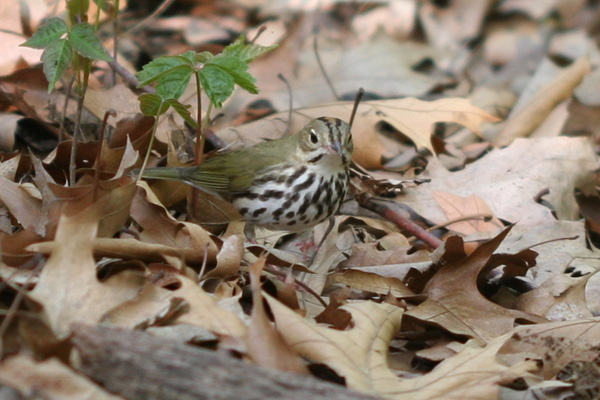
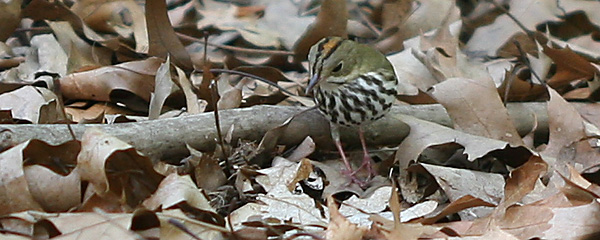
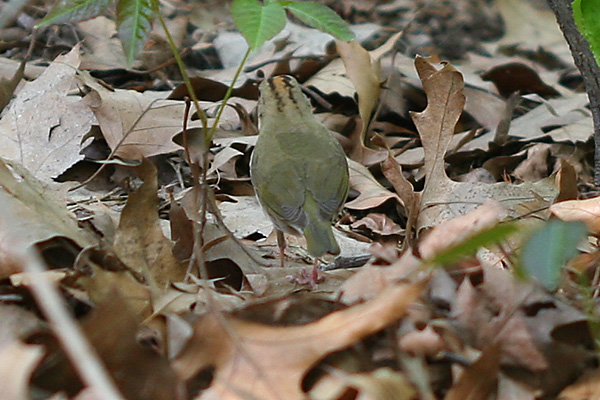
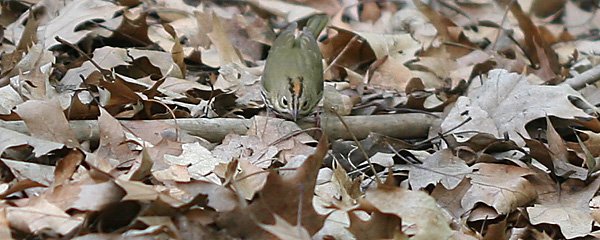
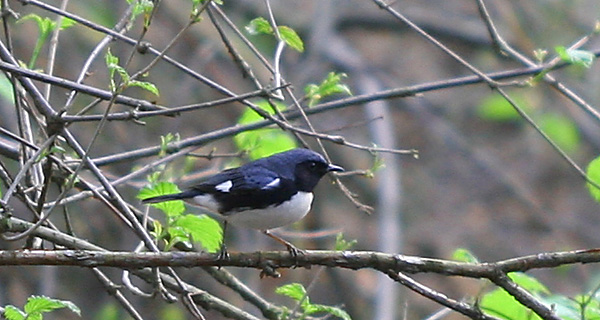
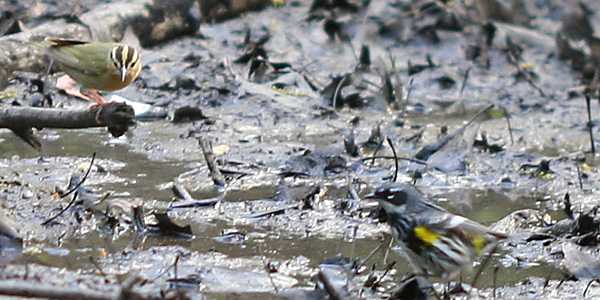
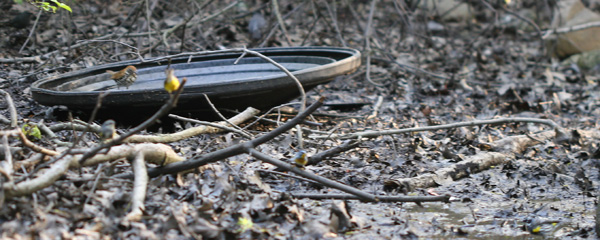











Well, I do see six species which I think are:
Am. Redstart (female or imm. male)
American Robin
Yellow-rumped Warbler
Northern Parula
Blue-winged Warbler
Wood Thrush
Try as hard as I might, I just can’t find No. 7, so it’s got to be the Worm-eating Warbler. I never have and probably never will be able to actually SEE those unless some birder has mercy on my soul and ties one to my binoculars.
Jochen, I haven’t seen an (expletive) Worm-eating Warbler yet either. But with the profusion of these birds that seem to have hit New York this spring, I’m liking my chances more and more.
Good luck, Mike! I heard two and missed one by a second or two: we were watching a particular bush at Pelee (for a Chat to pop up again), when I just turned around quickly to check what’s behind us, and then the lady right beside me calls out: “Oh, a Worm-eating Warbler just flew into the bush!” Of course I waited for more than an hour for the bird to show itself again, eventually walked off and later learned that a bit later, it did reappear and showed itself openly and nicely for a large birder crowd.
Expletive’s the word, Mike!
2 yellowrumps
Whoops… hit send too early.
2 yellowrumps
1 magnolia
1 parula
1 wood thrush
1 titmouse
and the one in the upper left corner looks vaguely like a brewsters
Are you kidding? I can only find two!
I would like to try my luck at winning the one year of a bird poop free head.
Common Yellowthroat- 1
Northern Parula- 1
Blue-winged Warbler- 1
Yellow-rumped Warbler- 2
Brown Thrasher- 1
Gray Catbird- 1
Tufted Titmouse- 1
Oh, um, oops. There are seven BIRDS in the picture but only six SPECIES…so if anyone wants to guess again, well feel free. I will now go stand under a tree until a bird poops on my head…
I also see 17 Wilson’s Snipe. 🙂
Whew, i was really trying hard to make a 7th species.
Northern Parula- 1
Blue-winged Warbler- 1
Yellow-rumped Warbler- 2
Brown Thrasher- 1
Gray Catbird- 1
Tufted Titmouse- 1
How about:
yellow-rumped wabrler x 2
Northern parula
brown thrasher
gray catbird
American robin
American redstart
Manky Mallards!
Okay, how about:
1 Am. Redstart (female or imm. male)
2 Gray Catbirds
1 Yellow-rumped Warbler
1 Northern Parula
1 Blue-winged Warbler
1 Wood Thrush
I don’t really know if I want to win though as being hit by bird poop is regarded by Germans as a sign that good luck is coming one’s way. So I’ll change the Blue-winged for a male Bachman’s Warbler, just to make sure I didn’t get them right by some wicked coincidence.
1 Wood Thrush
2 Yellow-rumped Warbler
1 Blue-winged
1 Parula
2 Catbird
For the life of me I can’t find any other birds. Looking forward to seeing the answers.
@Everyone: Well, all of the correct birds have been named, but no one has put them all together correctly yet. I’ll give the answer tonight…
Well then, I change my guess:
2 yellowrumps
1 Wood thrush
1 blue-winged warbler
1 parula
1 catbird
1 brewsters
One more try.
1 Wood Thrush
1 Am. Robin
1 Bluewing Warbler
1 Parula
1 catbird
2 yellow-rumps